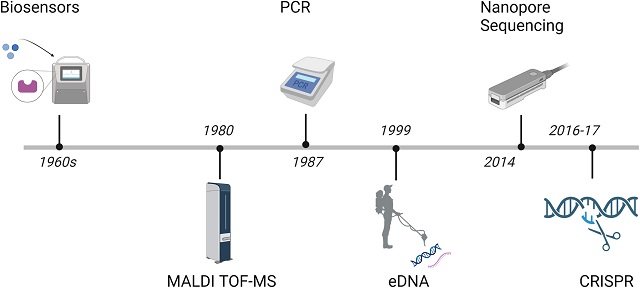
Aquaculturists are increasingly focusing on early diagnosis and disease monitoring to ensure higher productivity and economic performance. While experts in aquatic animal health have traditionally employed diagnostic methods like visual diagnosis, cell culture, histopathology, and serology, recent advances in aquamedicine are transforming the landscape.
The integration of cutting-edge technologies such as sequencing, biosensors, CRISPR, drones, artificial intelligence, and the internet into aquaculture operations is enabling rapid disease detection and real-time farm monitoring, leading to enhanced efficiency and sustainability.
In this context, researchers from the University of Arkansas at Pine Bluff and the University of Idaho, from the Animal Quarantine Office, have published a review that delves into emerging technologies capable of replacing conventional diagnostic and monitoring methods used in aquaculture. They explore the strengths, limitations, and potential future applications of these technologies in aquaculture settings.
The Technological Revolution
Sequencing Technology
One of the most significant breakthroughs in aquatic animal health is the use of DNA sequencing techniques. These methods allow researchers to identify pathogens within minutes by analyzing the genetic material present in a sample.
By identifying the specific disease-causing agents, aquaculturists can take immediate action to protect their aquatic populations, ultimately leading to higher production and reduced losses. Advantages of this technology include low cost, portability, and the absence of the need for sophisticated laboratories.
Biosensors
Biosensors are rapidly gaining ground in aquaculture. These innovative devices can detect specific molecules associated with diseases, toxins, or environmental changes. They offer a fast and accurate means of diagnosing health issues in aquatic animals, enabling early intervention and precise treatment.
However, the commercial application of biosensors is limited to specific tests due to regulatory issues, sensitivity, commercial viability, and coordination between biological and engineering researchers.
CRISPR Technology
The CRISPR-Cas system, initially a genetic editing tool, is now being adapted for disease detection in aquaculture. By designing CRISPR-based tests, farmers can rapidly identify diseases with high accuracy, providing an innovative approach to disease management in aquatic animal populations.
Matrix-Assisted Laser Desorption/Ionization Time-of-Flight Mass Spectrometry (MALDI-TOF MS)
In the aquaculture industry, this technology has been used to study various viruses, bacteria, fungi, and parasites. Additionally, MALDI-TOF MS has been employed to characterize and differentiate species in aquaculture. Some studies also focus on using these technologies in diagnosis.
“The advantage of MALDI-TOF MS technology is its ability to analyze samples within minutes of their cultivation with acceptable accuracy. Additionally, the cost per sample ranges between $1 and $3.14, excluding instrument costs,” the study reports.
However, the authors of the study highlight a significant limitation of this technology, which is the lack of precise identification of viral and fungal species. This is because accurate identification depends on established databases for pathogen identification, which are incomplete for aquatic pathogens.
Environmental DNA/RNA (eDNA/eRNA)
Environmental DNA (eDNA) and environmental RNA (eRNA) are innovative techniques for detecting DNA and RNA in air, water, and soil samples. This non-invasive method captures nucleic acids released by organisms.
This technique aids in disease diagnosis and monitoring in aquaculture. Researchers have reported the use of eDNA and eRNA in biosecurity measures during the trade of ornamental fish without the need to sample the fish directly.
Revolutionizing Aquatic Health Monitoring
Sensor Technology
Sensors are the heart of modern aquaculture farm monitoring. These devices, when strategically placed, continuously collect data on water quality, temperature, and other critical parameters. Real-time information enables farmers to make informed decisions, ensuring optimal conditions for aquatic animals.
Rapid disease diagnosis and changes in water quality can reduce treatment costs and maintain the economic viability of the aquaculture farm. It can also improve animal welfare, increase product quality, prevent disease transmission, and protect the environment.
Drones
Drones equipped with high-resolution cameras and environmental sensors are transforming how aquaculture farms are managed. They provide an aerial view of the farm, monitor fish behavior, identify potential issues, and assess the health of the aquatic environment.
Aquaculture employs three types of unmanned vehicle systems: unmanned aerial vehicles (UAVs), autonomous underwater vehicles (AUVs), and unmanned surface vehicles (USVs).
Artificial Intelligence and Machine Learning
The power of artificial intelligence (AI) is harnessed for data analysis. AI algorithms can process vast amounts of information, helping aquaculturists interpret data from sensors and drones, predict disease outbreaks, and optimize feed management, resulting in more efficient operations.
In aquaculture, different machine learning models can be implemented to analyze images. Information from individuals, drones, and sensors can be channeled into AI and machine learning platforms.
Closing the Knowledge Gap
While these advances are ushering in a technological revolution in developed countries, the challenge lies in extending their benefits to aquaculturists and educators in developing countries. The dissemination of information and technology, along with efficient training programs for agricultural educators, is crucial in bridging this knowledge gap. Collaborative efforts between governments, research institutions, and aquaculture companies can facilitate the adoption of these advanced technologies in regions where they are most needed.
Conclusion
Emerging technologies in aquatic animal health and monitoring hold tremendous promise for the aquaculture industry. Their continued development and adoption will result in greater efficiency, improved disease management, and ultimately benefit both farmers and consumers.
By embracing these innovations and ensuring their accessibility to a wider audience, we can pave the way for a more sustainable and productive future in aquaculture.
The study was funded by Agriculture Extension at 1890 Land-Grant Institutions (University of Arkansas at Pine Bluff).
Contact
Kailash Bohara
Department of Aquaculture and Fisheries, University of Arkansas
Pine Bluff, AR 71601, USA.
Email: boharak@uapb.edu
Reference (open access)
Bohara, K, Joshi, P, Acharya, KP, Ramena, G. Emerging technologies revolutionising disease diagnosis and monitoring in aquatic animal health. Rev Aquac. 2023; 1-19. doi:10.1111/raq.12870

